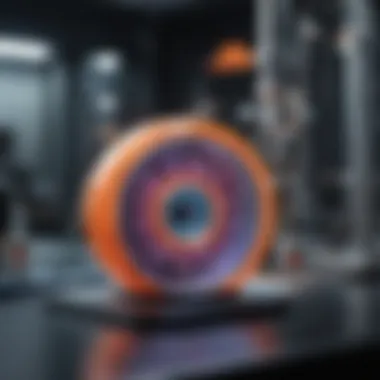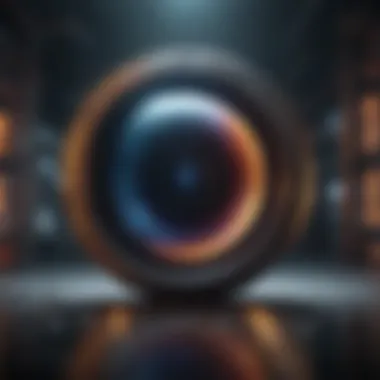Understanding Supercontinuum: Implications and Applications


Intro
Supercontinuum generation is a fascinating phenomenon within the field of photonics. By utilizing specific techniques, researchers can generate a broad spectrum of light from a single source. This process has significant implications across multiple disciplines, from telecommunications to advanced imaging systems. Understanding the fundamental principles of supercontinuum generation can enable advancements that may reshape technologies in ways we are only beginning to comprehend.
Key Findings
Major Results
One of the most striking findings regarding supercontinuum generation is its ability to produce light covering a wide range of wavelengths. This broad spectral output is particularly beneficial because it allows for various applications, such as enhancing the resolution in imaging systems or improving signal quality in fiber optic communications. Research indicates that supercontinuum light sources can achieve spectral bandwidths exceeding one octave, supporting diverse applications in medical diagnostics and optical coherence tomography.
The study also notes that using advanced materials, like photonic crystal fibers, optimizes the supercontinuum generation process, improving efficiency and output quality. Such materials enable the manipulation of light in ways that traditional optical fibers cannot, thus expanding the potential applications considerably.
Discussion of Findings
The implications of supercontinuum generation extend far beyond just improving existing technologies. It can offer new avenues for research in fields such as biophysics and materials science. As scientists explore the interaction of light with various substances at different frequencies, they can unveil previously unknown properties. This could lead to breakthroughs in sensors and imaging techniques that were not possible with conventional light sources.
Additionally, as telecommunication networks grow to accommodate high data rates, the significance of supercontinuum generation becomes even more evident. Such technologies promise to improve bandwidth efficiency and data transmission speeds, providing crucial support to the ever-increasing demands of global communication.
Methodology
Research Design
The research design for this exploration into supercontinuum relies on a combination of experimental practices and theoretical analyses. By implementing laboratory tests, scientists can accurately measure the output of various supercontinuum generation techniques while simultaneously applying theoretical understanding to predict outcomes.
Data Collection Methods
Data collection involves rigorous experimentation, wherein researchers observe the behavior of light as it passes through specially designed optical fibers. Furthermore, advanced imaging techniques are employed to visualize and quantify the spectral output of the system. Through this careful approach, researchers build a comprehensive understanding of the dynamics involved in supercontinuum generation.
"Supercontinuum sources are increasingly seen as a crucial technology for the next generation of optical systems, promising enhanced capabilities across diverse applications."
In summary, supercontinuum generation stands at the forefront of modern optics, with numerous implications for technology and research. As the field progresses, the insights gleaned from this technology will aid in unlocking innovations that could redefine our interaction with light.
Prelude to Supercontinuum
Supercontinuum generation is a significant topic in modern photonics. It encompasses the creation of a broad spectrum of light from a narrow input by employing nonlinear optical processes. This concept holds great relevance for many applications, including telecommunications, imaging, and spectroscopy. Understanding the implications of supercontinuum technology opens up new avenues for research and innovation.
Definition and Significance
Supercontinuum refers to the generation of a continuous spectrum of light covering a wide range of wavelengths, often extending from the infrared to the ultraviolet region. This phenomenon typically occurs when a short pulse of light travels through a nonlinear medium, such as a specially designed optical fiber. The significance of supercontinuum lies in its ability to produce high-intensity light that maintains coherence over a broad spectral range. This coherence is crucial in various applications, enhancing resolution and sensitivity in imaging systems and allowing for improved signal integrity in telecommunications.
The versatility of supercontinuum sources makes them highly sought-after in research and industry. They can replace traditional light sources in many advanced applications due to their wide spectral output. Moreover, the ability to tailor the output spectrum by modifying parameters of the nonlinear medium presents exciting possibilities for the development of next-generation photonic devices.
Historical Context
The journey of supercontinuum generation began in the late 20th century. An early milestone was in the 1970s when researchers started exploring nonlinear optics. This field gained traction along with the development of high-power laser sources. Notably, the invention of fiber optic technology in the 1980s allowed for more efficient nonlinear interactions, leading to the first experimental observations of supercontinuum generation.
Over the years, significant advancements in fiber design and nonlinear materials have paved the way for practical supercontinuum sources. The emergence of photonic crystal fibers in the late 1990s was particularly groundbreaking. These fibers showcased enhanced nonlinear properties, enabling the generation of supercontinuum light that was more stable and broader than previously achieved. As a result, supercontinuum technology has transitioned from laboratory curiosity to an essential tool in various fields, underpinning many modern optical applications.
Fundamental Principles
Understanding the Fundamental Principles of supercontinuum generation is crucial. These principles form the backbone of how supercontinuum light is produced and manipulated. The intricate interplay of light in nonlinear media leads to a wide spectrum of consequences for various applications, from telecommunications to imaging.
Nonlinear Optics Overview


Nonlinear optics is the study of light behavior in materials where the response is not proportional to the electric field's strength. In this context, phenomena like frequency doubling or third-harmonic generation occur. This nonlinearity is what makes supercontinuum generation possible. When intense laser pulses enter a nonlinear medium, they interact with the material's atomic structure, resulting in changes to both the intensity and phase of the light. This interaction ultimately leads to the production of a continuum of wavelengths, spanning from the infrared to the ultraviolet. The understanding of nonlinear optics is essential to harnessing supercontinuum light effectively.
Pulse Propagation in Media
Pulse propagation describes how laser pulses travel through various media, and this concept is fundamental to supercontinuum generation. When a short pulse of light enters a nonlinear medium, its shape can change significantly. Different frequencies within the pulse travel at different speeds due to the medium's characteristics. This phenomenon, known as group velocity dispersion, causes the pulse to broaden. If the pulse is intense enough, it causes a nonlinear interaction that generates new frequencies. This process is key for creating a broad spectrum of wavelengths, essential for supercontinuum sources.
Wave Mixing and Self-Phase Modulation
Wave mixing refers to the interaction between different light frequencies within a nonlinear medium, which can create new frequencies. Self-phase modulation is a specific type of wave mixing where the pulse's intensity affects its own phase, leading to the generation of new frequency components. This self-induced change can enhance the diversity of wavelengths in a supercontinuum spectrum. Understanding these two mechanisms is important, as they allow researchers and engineers to optimize conditions for generating a high-quality supercontinuum output.
"The ability to generate and manipulate a broad light spectrum opens up new avenues in scientific research and practical applications."
Methods of Supercontinuum Generation
The generation of supercontinuum light is a pivotal topic in understanding its wide-ranging applications. Methods of supercontinuum generation are crucial as they define the capabilities and efficiency of this phenomenon. Different methods have distinct advantages and considerations. Each method shapes the resulting spectrum and its practical utility in various fields. Overall, these methods are fundamental for advancing supercontinuum technology in both research and commercial applications.
Fiber-Based Supercontinuum
Fiber-based supercontinuum generation is a widely studied approach that has gained significant prominence in recent years. This method utilizes optical fibers that possess nonlinear optical properties. The inherent advantages of fiber-based systems include their compact size and capability for long-distance propagation.
Within fiber-based supercontinuum generation, there are usually two types of fibers utilized: conventional silica fibers and ** photonic crystal fibers**. Silica fibers are well-established, but photonic crystal fibers have opened new avenues. They allow for tailored dispersion properties and enable broader bandwidth generation.
Moreover, fiber optic systems generally benefit from effective management of dispersion, which is vital in maintaining pulse stability. This affects overall efficiency and the output spectrum. The trends in research speak to a notable focus on optimizing fiber design, enhancing nonlinearity, and improving the overall performance of the system.
Femtosecond Laser Techniques
Femtosecond laser techniques represent another robust method for generating supercontinuum light. These lasers emit extremely short pulses, on the order of femtoseconds, facilitating efficient interactions with nonlinear media. The high intensity of these pulses results in significant nonlinear effects, which lead to broad spectral outputs.
Key advantages of femtosecond lasers include their ability to generate ultra-broad supercontinuum spans with great coherence and stability. Such characteristics make them suitable for precise applications such as imaging and sensing. However, the necessity for complex setups and technical expertise in manipulating femtosecond pulses can present challenges.
Moreover, research continues to progress in this area, with innovative techniques aiming to improve stability and efficiency in pulse generation. Adapting femtosecond laser outputs for specific applications also remains an area of exploration.
Bulk Nonlinear Media Approaches
Bulk nonlinear media approaches focus on utilizing solid or liquid materials to achieve supercontinuum generation. This method involves placing short laser pulses in nonlinear crystals, glasses, or liquids to produce a broad spectrum of wavelengths.
One important aspect of this method is the variety of materials that can be used. Barium titanate and potassium titanyl phosphate are examples of nonlinear media that exhibit strong nonlinear optical properties, enabling extensive spectral coverage. These materials provide flexibility and allow for customization according to the desired application.
However, bulk nonlinear media approaches can be limited by factors such as damage thresholds and efficiency. Their practical implementation often requires elaborate experimental setups and precise control of parameters. Consequently, further research is essential for optimizing material choices and refining production methodologies.
Overall, understanding these generation methods is a fundamental aspect of advancing supercontinuum technology and maximizing its practical applications across various industries.
Applications of Supercontinuum Technology
The applications of supercontinuum technology hold significant importance within various fields, demonstrating impressive versatility and advancement capabilities. This section delves into how supercontinuum generation enhances several domains, particularly imaging, telecommunications, and spectroscopy. Understanding these applications can help clarify the broader impacts of supercontinuum on modern technology and science.
Imaging and Sensing
Medical Imaging Techniques
Medical imaging techniques benefit greatly from supercontinuum sources. One specific aspect is the broad spectral output provided by supercontinuum. This feature allows for enhanced contrast and detail in imaging. The key characteristic of supercontinuum sources, such as their high brightness and coherence, makes them a popular choice for in vivo imaging applications.
For instance, utilizing supercontinuum in optical coherence tomography (OCT) allows probing of biological tissues with exceptional clarity. The unique feature of this approach is its capability to capture high-resolution images of tissue structures without invasive methods. However, there are some limitations regarding the complexity of the equipment and the skill necessary for operation. Still, the advancements in this technology present considerable advantages in diagnostics.


"Supercontinuum sources significantly enhance the resolution and speed of medical imaging techniques, which can lead to earlier diagnoses and improved patient outcomes."
Environmental Monitoring
Environmental monitoring relies heavily on supercontinuum sources to analyze various pollutants and gases. The specific aspect here is the use of supercontinuum in spectroscopy to measure concentrations of different substances in the environment. This is especially crucial for detecting contaminants in water and air quality.
The key characteristic is the ability to capture a wide range of wavelengths. It offers a beneficial way to study multiple analytes simultaneously. One unique feature of supercontinuum in this context is its flexibility to be integrated with portable devices for field measurements. Nevertheless, the challenges can include sensitivity to environmental conditions, which may affect readings.
Telecommunications Enhancements
Telecommunications experience notable advantages thanks to supercontinuum technology. The capacity for supercontinuum generation to provide a broad bandwidth allows for increased data transmission rates. Often, fibers employing supercontinuum sources can achieve better performance and efficiency compared to traditional methods.
Moreover, supercontinuum can optimize the allocation of wavelengths for various channels, addressing congestion in high-demand networks. This is a crucial consideration for current and future telecommunication systems as global data usage continues to rise. However, implementation can be expensive, and technical expertise is required to fully leverage this technology.
Spectroscopy Applications
Raman Spectroscopy
Raman spectroscopy's effectiveness is enhanced by supercontinuum sources by providing a broader spectral output. The specific aspect of using supercontinuum in Raman spectroscopy is its ability to achieve high-resolution signals from samples. Such characteristic makes supercontinuum a beneficial choice for applications in materials science and pharmaceuticals.
The unique feature is the capacity for simultaneous multi-wavelength excitation, which enhances sensitivity. Despite this advantage, some challenges exist in terms of cost and complexity of the associated systems.
Fourier Transform Spectroscopy
Fourier transform spectroscopy also benefits immensely from employing supercontinuum light sources. The specific aspect to note is the ability to obtain spectrum data swiftly and accurately due to the continuous bandwidth that supercontinuum provides.
This characteristic ensures reliable measurements crucial for various scientific research. Moreover, supercontinuum light allows for high spectral resolution. The unique feature of this method is its effectiveness in capturing transient phenomena in dynamic systems, a significant advantage in research and industrial applications. However, like Raman spectroscopy, it can be cost-prohibitive and requires substantial expertise to implement effectively.
Challenges in Supercontinuum Generation
The process of supercontinuum generation is marked by significant scientific promise and potential applications, yet it is also beset by various challenges that researchers must address. Understanding these challenges is crucial to advancing supercontinuum technology and unlocking its full potential across diverse fields such as telecommunications, sensing, and medical imaging. In this section, we will explore three fundamental challenges in supercontinuum generation: material limitations, efficiency issues, and stability concerns. Each of these factors not only poses hurdles but also presents opportunities for innovation and advancement.
Material Limitations
The choice of materials used in supercontinuum generation is pivotal. While silica optical fibers have dominated the field due to their favorable nonlinear optical properties, there are inherent limitations in terms of bandwidth and performance. For instance, the nonlinear coefficient of a material determines its capability to generate supercontinuum light, and silicone fibers often fall short in certain wavelength ranges.
The limitations come in various forms:
- Wavelength Range: The effective generation of supercontinuum light is often restricted to a specific wavelength range, depending on the material properties.
- Nonlinearity: Some materials may have lower nonlinearities, which hampers the ability to produce the broad spectra necessary for effective applications.
- Fabrication Challenges: The complexity of producing high-quality optical fibers can lead to inconsistencies, further impacting their performance.
Overall, these material constraints necessitate ongoing research into alternative media and fabrication methods that can better exploit the potential of supercontinuum generation.
Efficiency Issues
Efficiency is a critical concern in supercontinuum generation. The energy used in generating the supercontinuum must be optimized to ensure practical applications are feasible. Several factors contribute to low efficiency:
- Pump Power Requirements: Generating a supercontinuum often requires high pump powers to achieve the nonlinear effects necessary for broad-spectrum generation, which can lead to increased operational costs.
- Losses in Transmission: High losses in experimental setups can lead to inefficiencies in the conversion of pump energy to the desired output spectrum. Material absorption and scattering losses can significantly diminish overall efficiency.
- Complexity of Setup: Many methods require elaborate setups, leading to high costs and practical challenges that can deter widespread use.
To improve efficiency, research efforts focus on optimizing pump wavelengths and employing novel structures such as photonic crystal fibers, which may offer enhanced performance due to their unique dispersion properties.
Stability Concerns
Stability is an essential facet of supercontinuum generation that can affect the reliability of outputs in real-world applications. Fluctuations in output power and spectral features can prevent consistent performance. Some key stability issues include:
- Temporal Stability: Variability in the output signal over time can lead to unpredictable results, complicating applications in precise measurement and sensing.
- Environmental Factors: Changes in temperature, humidity, and other environmental conditions can influence the physical properties of the materials used and alter performance.
- Mode Instability: In fiber-based approaches, unstable modal behavior can lead to erratic supercontinuum generation, requiring careful tuning of parameters.
Enhancing stability can involve advanced stabilization techniques or the development of resilient materials that can perform uniformly across varying environmental conditions.
Addressing these challenges is crucial for maximizing the impact and applications of supercontinuum technology across diverse scientific fields.
Current Research Trends


Research trends in supercontinuum generation reveal the direction of advancements and understandings within the field. As technologies evolve, numerous paths have opened up to enhance the capabilities and applications of supercontinuum light sources. These trends bear significant implications for various industries, from telecommunications to biomedical applications. In this section, we will explore the ongoing advancements in fiber designs, integration with quantum technologies, and innovations in nonlinear materials.
Advancements in Fiber Designs
Recent research has focused on the development of specialized fibers to optimize supercontinuum generation. These fibers are engineered to maximize nonlinear interactions, thus improving output efficiency. New designs include photonic crystal fibers, which offer unique refractive index profiles. This structural modification allows for broader bandwidths and finer control over dispersion properties. The incorporation of different materials and geometries has been pivotal in achieving significant enhancements in supercontinuum output.
Moreover, researchers are investigating the use of tapered fibers. By gradually reducing the fiber diameter, these structures amplify the intensity of light confined within, leading to increased nonlinear interaction lengths. Experimentation with varying core shapes is also gaining traction, demonstrating potential in achieving tailored dispersion management. The flexibility in designing fiber optics is paramount to address specific demands in various applications.
Integration with Quantum Technologies
The intersection of supercontinuum generation and quantum technologies is an emerging trend that deserves attention. The uniqueness of supercontinuum light, often operating in a broad spectrum, can significantly benefit quantum communication systems. By leveraging quantum superposition and entanglement, researchers are exploring methods to generate entangled photon pairs from supercontinuum sources. This application is crucial in developing secure communication systems and advanced quantum networks.
Additionally, utilizing supercontinuum light for quantum sensing is gaining ground. Its broad spectral width provides additional data points for simultaneous measurements across multiple wavelengths, enhancing sensitivity and accuracy in quantum state readings. The potential here opens a dialog about new frontiers in quantum mechanics and information theory, impacting how we understand and manipulate light.
Innovations in Nonlinear Materials
The exploration of new nonlinear materials is another significant area of research in supercontinuum generation. Advances in material science have led to the development of novel compounds, such as metallic glasses and other organic materials. These innovations aim to enhance the nonlinear optical response while enabling effective light-matter interactions at relatively lower input powers.
Research efforts are also directed towards optimizing existing materials, particularly silica and fluorides, to improve their nonlinear properties and bandwidth limitations. By enhancing these materials, researchers have successfully improved the thresholds for supercontinuum generation, thereby paving the way for more compact and robust systems.
In summary, the current research trends in supercontinuum generation influence not only the physics behind light propagation but also its expansive applications across various fields. The ongoing work in fiber designs, quantum technologies, and nonlinear materials showcases a vibrant and evolving area of study that holds promise for the future.
"Innovation is the key driver for advancing the field of supercontinuum generation, impacting both fundamental science and practical applications."
Future Prospects of Supercontinuum Technology
Supercontinuum technology stands at the forefront of optical advancements. As this field continues to evolve, the future prospects appear increasingly promising. Innovations in this area could lead to major breakthroughs across numerous industries. This section focuses on emerging applications and the potential for significant market impact.
Emerging Applications
The versatility of supercontinuum light sources allows for expansion into several cutting-edge applications. Some notable areas include:
- Medical Diagnostics: Enhanced imaging techniques, particularly in the field of optical coherence tomography (OCT), can improve diagnostics in ophthalmology and cardiology.
- Environmental Monitoring: Supercontinuum sources can enhance sensor technologies for real-time monitoring of environmental conditions, such as air quality and water purity.
- Telecommunications: The ability to transmit vast amounts of data efficiently can transform communications infrastructure, supporting demands for higher bandwidth.
- Material Analysis: Advanced spectroscopy techniques using supercontinuum light can enable precise material characterization, crucial for research and quality control.
As these applications mature, they hold potential to transform industries and enhance capabilities across various sectors.
Potential in Emerging Markets
Emerging markets present unique opportunities for supercontinuum technology. Several factors make investing in these regions particularly attractive:
- Growing Demand for Technology: Increased connectivity and the need for advanced communication solutions create a growing market for supercontinuum applications.
- Innovation-Driven Economies: Regions focusing on research and development are likely to adopt supercontinuum technologies, leading to collaborative opportunities.
- Government Support: Policies that favor technology adoption may further encourage investment and development in supercontinuum generation.
- Educational Institutions: An emphasis on STEM education will cultivate a workforce that can drive innovation using supercontinuum technologies.
Ending
The conclusion of this article serves several critical functions, encapsulating the essence of supercontinuum technology and its substantial implications across diverse fields. It solidifies the understanding of how this technology operates and its significant contributions. Supercontinuum generation is not just an academic pursuit; it opens avenues for practical applications that reshape imaging and telecommunications, making them more efficient and capable.
Summary of Key Points
In summarizing key points from the article, we highlight the following aspects:
- Definition and Importance: Supercontinuum generation is characterized by broad spectral output achieved by nonlinear interactions in various media. Its significance lies in enabling high-resolution imaging and advanced sensing.
- Methods of Generation: The discussion of infrastructural variations, such as fiber-based techniques, femtosecond lasers, and bulk nonlinear media, illustrates diverse methodologies in producing supercontinuum light.
- Applications: The real-world implications span from medical imaging tools to telecommunications advancements and spectroscopy applications, showcasing technology's versatility.
- Challenges: Material limitations, efficiency issues, and stability concerns present ongoing challenges that need attention in the research community.
- Future Prospects: Emerging applications and potential market growth indicate a bright future for supercontinuum technology, underscoring the necessity for sustained innovation.
The Importance of Continued Research
Continued research in supercontinuum technology is vital for several reasons. As applications evolve, so must the underlying technologies. Innovations in fiber designs and nonlinear materials will increase efficiency and broaden the range of applications. Additionally, incorporating supercontinuum with quantum technologies can lead to breakthroughs that drive forward next-generation tools in communications and sensing. Encouraging collaboration among researchers and industries will also foster a more profound understanding of the complex dynamics at play, leading to better materials and generation methods.
In summary, the continued exploration of supercontinuum technology reinforces its critical role in shaping modern applications and advancing scientific knowledge.
"The future of supercontinuum technology is not only promising but essential for continued advancement in optics and photonics."
By recognizing the significance of ongoing research, stakeholders can ensure that the potential of supercontinuum generation is fully realized, enhancing both practical applications and theoretical frameworks.



